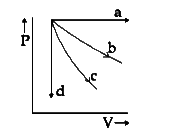What are isothermal and adiabatic changes ? Show their p.V diagram.Solution in Odia
Step by step video & image solution for What are isothermal and adiabatic changes ? Show their p.V diagram. by Physics experts to help you in doubts & scoring excellent marks in Class 12 exams.
Updated on:21/07/2023Topper's Solved these Questions
Similar Questions
A glass window pane 1 m by 1 m is 25 mm thick. If the show outside maintains the outer surface at 0∘C and the heat of the room maintains the inner surface at 6∘C ,Thermal conductivity of glass in S.I unit is 0.2, how much heat will be conducted through the glass in 1 day ?
View SolutionFind out the magnitude of the orthogonal components of a displacement vector in space .
View SolutionIn which of the following indicator diagrams gives below do AB,BC , and CA represent isothermal, isochroic, and adiabatic changes, respectively?
View SolutionIdentify isothermal and adiabatic process in the following diagram
View SolutionGive two examples each of (a) an isothermal change and (b) an adiabatic change.
View SolutionSTATEMENT-2: In a gas , any rapid change must be adiabatic, whereas a slow change may be adiabatic.
STATEMENT-2: In a p-V diagram, the magnitude of the slope is greater for an adiabatic process than for an isothermal process.
View SolutionThe gas lawPVT= constant is true for
(A) Isothermal changes only
(B) Adiabatic changes only
(C)Both isothermal and adiabatic changes
(D) Neither isothermal nor adiabatic changes "
View SolutionWhat are Isothermal and Adiabatic process?
View SolutionThe given diagrams shows four processes i.e., isochoric , isobaric , isothermal and adiabatic. The correct assignment of the processes in the same order is given by:

View SolutionShow adiabatic elasticity is greater than isothermal elasticity.
View SolutionSample of gases are taken through isothermal and adiabatic process. Choose which of the following diagram correctly represent isothermal and adiabatic process
View SolutionShow that the adiabatic curve is steeper than the isothermal curve.
View SolutionIn which of the following indicator diagrams gives below do AB,BC, and CA represent isothermal, isochroic, and adiabatic changes, respectively?
View SolutionGive the definition of isothermal and adiabatic change.
View SolutionShow adiabatic and isothermal processes on a single P-V diagram.
View Solution
